
The large-scale coronal structures (LSCS) such as coronal loops and streamers,
coronal holes (CHs) and eruptive protuberances are of great interest as
visible indicators of solar global and cyclic activity. This structures
are involved in local magnetic interconnections. LSCS are clearly seen in soft
X-ray images provided by the Soft X-ray Telescope (SXT) on the Yohkoh satellite.
Unlike an optical coronograph, groundbased radio telescopes enable
us to study the LSCS on both the solar limbs and the solar disk.
§ 1. Coronal magnetic field, plasma density and temperature
evaluated from radio observations
There are a set of evaluation techniques of magnetic field H, plasma
density N, and temperature T based on radio observations. The techniques applied
to LSCS can operate the integrated radio flux spectrum and the local radio
brightness of the LSCS.
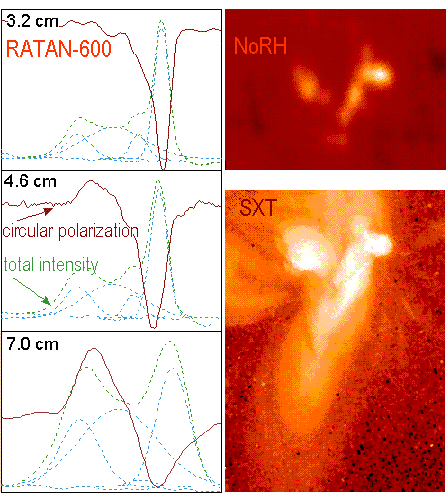
Coronal streamer at soft X-ray and radio wavelengths
|
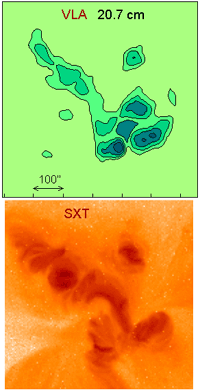
Giant coronal loops
|
By now the height dependence of plasma density and temperature
has been obtained for CHs and the quiet solar atmosphere. The local values of H,
N, and T are evaluated for some regions of interest inside the coronal loops and
coronal streamers. Spectral polarization microwave observations are conducive for coronal
plasma diagnostics and LSCS tracing. The most intriguing phenomena are thought to be
the evolution of the radio flux and plasma parameters before a solar flare or
a coronal mass ejection (CME) and the reconnection or disruption of the coronal
magnetic structure (a coronal loop or a coronal streamer) occur.
With the polarimeter scheduled for
the Ventspils 32-meter radiotelescope RT-32
(Stokes I, V at the wavelengths 2 - 3 cm with the angular resolution of 2'.9 - 4'.3),
the microwave emission from the chromosphere - corona transition region and dense
coronal plasma regions inside LSCS is under investigation. At the wavelengths
mentioned above more than a half of radio emission comes from the legs of LSCS in
the solar chromosphere. Nevertheless some LSCS could be resolved at coronal heights
especially by means of soft X-ray
(Yohkoh)
and extreme - ultraviolet
(SOHO) images.
§ 2. Model simulations
Our goal is to provide some microwave polarization observations
taken with the RT-32 to the international joint observational projects "Whole Sun Month" and
"SOHO Coordinated Observations"
to contribute to the analysis of LSCS in various wavelength domains.
Our model simulations of LSCS at microwaves enable us to determine the level
of heat conduction flux and to reveal some unknown features of the LSCS.
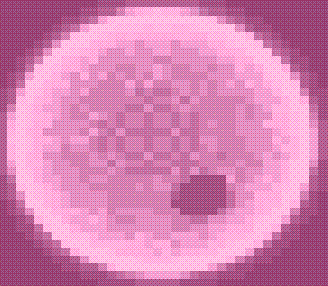
Radio Sun with a coronal hole
(model simulations for the wavelength 32 cm) |
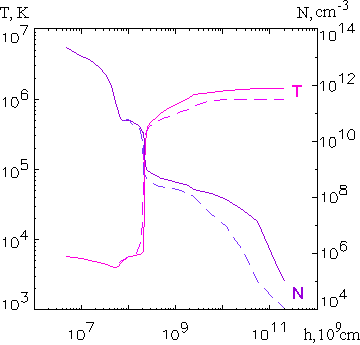
Temperature and density via height
in the quiet solar atmosphere (solid line)
and in a coronal hole
(dashed line)
|
§ 3. Benefits of analysis in others wavelength domains
Polarizational radio observations can provide some values of coronal
magnetic fields. Those are of exceptional importance for stability and evolution
studies of LSCS before a solar eruption (a solar flare or a CME) occurs. The search
for the LSCS on the Sun can be based on radio maps at the wavelength 2.8 cm
(angular resolution 3'.9). Large coronal arches, active prominances, dence coronal
rays and others are under consideration to find out their interaction with small-scale
magnetic structures. For this purpose it is essential to analyse different types
of observations, including soft
X-ray (Yohkoh) ,
UV (SOHO) ,
and
radio (RATAN-600) .
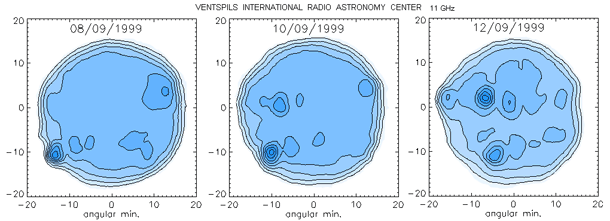
|

A comparison of soft X-ray image (from Yohkoh SXT)
and raw 2.8 cm radio image (from the VIRAC RT-32)
for the Sun observed on 1999 September 8, 10, and 12.
|
Last update September 3, 2003








